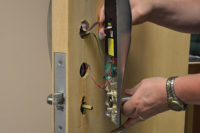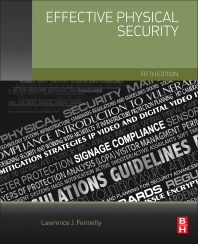The latest developments in magnetic locks and strikes mean dealers and integrators have more technology options for keeping high-security openings secure. And the available products are easier to install, as well.
“Manufacturers are making magnetic locks and strikes stronger so they are not the weakest point of the opening,” says Bob Lafrance, vice president of marketing and sales, Rutherford Controls, Cambridge, Ontario, Canada. “This can be done in three different ways: the strength of the product itself, anti-tampering features, and monitoring options.”
Electromagnetic locks and strikes today are also smarter and sleeker, and the choices are simpler than in the past. Whereas a magnetic lock may have been the obvious choice a few years ago, electric strikes and electrified hardware are now viable options as well, and offer a better installation experience than before.
But before an installer can decide which of the latest advancements to employ, he first needs to decide which type, style and size of product will be the best fit for the opening.
CHOOSING A LOCK
“The most important thing for an integrator or dealer to consider is the entire opening they are trying to secure,” Lafrance says. “Look at the strength of the frame around the door; understand what type of door, wooden or metal. If you are trying to have a high-security type of opening but have a weak door or side light or glass in the door, you are really not going to be able to achieve high security. From there consider what the risk factors are. What are you trying to secure — is it from a cost perspective? people? inventory? What is the exposure of this opening and how much will it cost for this door to be breached?”
Mark McBroom, product manager at Securitron Magnalock, an Assa Abloy company, Sparks, Nev., agrees.
“A lot of times the lock chosen is 500 or 1,000 pounds stronger than the opening it is trying to secure. You need to understand what the strength of the door is before you go after the highest security device. It is important to really assess the entire opening going back to the number of users and what is on the door right now? Can I use the hardware on the door and electrify something other than that? Do a total assessment of the door.”
Once that is accomplished, then you can better assess whether an electromagnetic lock, electric strike or other electrified hardware is the best way to go.
“There are several considerations,” says Tamara Hatzinger, brand manager, HES, an Assa Abloy company, Phoenix, Ariz. “Do you have extreme force conditions? If you need 4,000 pounds of holding force a magnetic lock may be the best way to go.
“Another aspect is budget. When you look at electrified door hardware versus strikes versus magnetic locks, what is your price point and what are the requirements of the end user? Electric strikes are a good value proposition that allows integrators to bring more openings under access control than if you were going with an electrified lock. It also depends on whether it is retrofit or new construction. If you are doing new construction and have the ability to design solutions, electrified locking hardware may very well be the best option. In a retrofit situation, strikes and mag locks are often seen as the best solutions,” Hatzinger advises.
One area where magnetic locks are more likely to be the best choice is where high security and life safety converge, such as in a hospital, airport or retail application.
“If you are looking at a strike, normally you are talking free egress,” Lafrance adds. “If you are looking to control egress, it is usually a magnetic lock.”
One reason for this, McBroom explains, is that magnetic locks are always fail safe, where electric strikes can be fail safe or fail secure. “Typically in a high-security environment you want fail secure, but mag locks are inherently fail safe. When you are dealing with high security but also with life safety issues, magnetic locks will release when the power is cut.”
MAGNETIC LOCK ADVANCES
Magnetic locks often are considered higher security because of their higher holding force. Recent technology and product advancements have increased their security by adding anti-tampering and monitoring measures.
“What manufacturers have developed recently are much better reporting capabilities of the lock referring to holding capabilities, whether the armature is in the correct position and bond status,” McBroom describes. “It is a way of internally monitoring a lock’s holding force via internal components that watch current draw and the position of the armature plate to ensure that they are getting the holding force the mag lock is capable of."
Door status or security condition sensors tell the monitoring company that the door is closed. Bond status sensors report how strong the bond is on the magnetic lock.
“Let’s say the door doesn’t shut properly or someone puts a piece of paper between the mag lock and armature plate — bond status sensors will report that the amount of holding force isn’t correct,” Lafrance says.
Rutherford has a magnet that recognizes a specific armature plate,” Lafrance adds.
“If you think of an armature plate and think of someone trying to break in you could literally grab an armature plate and put it up against a lock and it would think it was closed. This lock has a feature in it that says ‘this isn’t the right armature plate.’”
A feature Rutherford introduced recently is an early warning sensor. “When there is pressure of 55 pounds or more on the door for more than four seconds, a signal is sent to the monitoring company that someone is trying to break into that door,” Lafrance describes. The door also alarms, similar to a car alarm, as a further deterrent.
Some manufacturers are combining a small camera with a magnetic lock on the inside of the door. “It is a discreet built-in camera that gets a picture of anyone trying to get out of a door they are not authorized to go through, without them being aware of it,” Lafrance says.
On the physical side, magnetic locks are getting away from the “brick” look and becoming smaller and more aesthetic and using less power, McBroom says. This is still a future product for many, though.
“We are all trying to get a smaller magnetic lock but technology hasn’t so far allowed that to happen,” McBroom explains.
Rutherford has a small device called the MEM lock, a mechanical electromagnetic lock, Lafrance says, but it is not currently sold through distribution. “It is about one-fifth the size of a regular mag lock with the same holding force and early warning features, but it has a mechanical plunger-type device that is held by the mag lock mechanically. But we don’t sell many to the public yet because of building code stipulations regarding moving parts and mechanical locks with respect to life-safety doors. Still, this is a good example of where we are coming up with smaller products that use less power, which is where the industry is heading.”
ELECTRIC STRIKE & HARDWARE ADVANCES
The tightening of code restrictions for magnetic locks in fact has been a boon to electric strike and electrified hardware, especially as manufacturers have stepped up with easier-to-install no-cut and field-selectable strikes and retrofitable electric locks.
“Magnetic locks were originally designed for locking perimeter doors equipped with exit devices to discourage business owners from illegally chaining the panic bars together for security,” says Rick Geringer, vice president, director of marketing, SDC, Camarillo, Calif. “Due to the fact that magnetic locks were so easy to install with no moving parts to wear out or malfunction, they have been used inappropriately for other applications. Today’s installers are now more educated to the pitfalls of using magnets for everything and have returned to increased use of electric locksets that comply with the code requirements of many more applications.”
Dave Malen, general manger, Camden Door Controls, Toronto, Ontario, Canada, agrees. “Electric strikes now are an easier and more viable alternative to magnetic locks. Most installation companies would agree that the magnetic lock is superior in terms of security. But because of recent changes in codes, it is becoming more and more difficult to comply with the code and get the fire marshal to sign off (see related article, “How the Codes Are Viewed,” on this page). Many security companies are moving towards strikes as the preferred means of securing property.”
And strikes manufacturers are making it an easier selection and installation than in the past.
“With strikes, one of the trends we have seen over the past few years is field selectability,” Malen says. “Many of our models as well as our competitors are now field-selectable for fail safe or fail secure, AC/DC and 12 or 24 volts. In the past in any one series you might have had six to 10 models
for each of those applications. Now you have a ‘universal’ strike that can accommodate a variety of installations or field applications, making it easier for the installer and offering a lot more flexibility.”
No-cut strikes are another development bringing installation of strikes into the realm of the mag lock in terms of simplicity.
“In traditional strikes there is a lip bracket that the installer has to cut the frame to accommodate,” Malen explains. “Many security companies don’t have the tools or the inclination to start cutting away on door frames, potentially damaging them. No-cut strikes have made a huge difference in terms of speed and ease of installation.”
HES is making it easy on the installer in a different way by offering an integrated access control reader with a pre-integrated strike, Hatzinger says. “All the hardware they need to secure the door is in one easy package with pre-integrated wiring harnesses so regardless of what kind of strike they need to interact with the door lockset and any of the credential formats, the installer will have a repeatable, predictable installation experience. It is one-box ordering. One SKU gets you all the elements you need to secure the door properly.”
It is easier to apply electrified locksets, too, to more applications, Geringer says. “A training course called the Perfect Raceway Program is designed to train installers and integrators how to drill a wire raceway through a fire-rated door without voiding the door’s fire rating. This provides increased sales and installation of electric locksets in the retrofit market.”
In the past electrified locksets, were generally confined to new construction. “Integrators are discovering electrified locksets are more practical and are very code-friendly, solve many applications, are concealed and have outputs unavailable on other locking devices,” Geringer adds.
Like magnetic locks, however, even the strongest electric strikes can be vulnerable to tampering or fooling. Electric strikes, too, offer latch-monitoring options to heighten security.
“Many strikes are available with latch monitoring as an option,” Malen says. “If someone were to wedge something in the strike, the system would be alerted. We are seeing that becoming more available to enhance security.”
Hatzinger adds that higher-security applications require layered monitoring. “It is not enough just to use a door-position switch. In order to be confident that the door is secure, you want to be able to confirm remotely that the strike is fully engaged and locked.
“There is a pocket that the latch bolt sits in. With latch-bolt monitoring and latch-bolt-strike monitoring there is some sort of sensor or plate in that pocket so that the strike will know that the latch bolt and keepers are locked in place. Different signaling points give feedback to the access control system so someone monitoring events can see all the components around that lock are engaged and make sure someone hasn’t taped the latch bolt down.”
Like mag locks, low-power options are on the horizon for electric strikes as well. “The introduction of several new electric latch retraction designs for exit devices have insignificant or no high-current inrush, with a fraction of the power consumption,” Geringer describes. “This development has also eliminated the need for expensive and specially designed high-current power supplies.”
|
Beyond the Door: Securing Other Openings |
|
Electric strikes and magnetic locks are branching out beyond the door to smaller applications.
Tamara Hatzinger, brand manager, HES, credits Homeland Security with increasing such demand. |
| How the Codes Are Viewed |
|
“We are seeing a slight decrease of mag-lock popularity due to the code officials not understanding the codes. Going forward, codes are being written much more clearly to define electromagnetic locks in terms of where they can be used to make them safer and more secure. In the past, codes were defined very loosely. I think magnetic locks will come back as independent areas start to adopt new, more clearly written codes.” |










